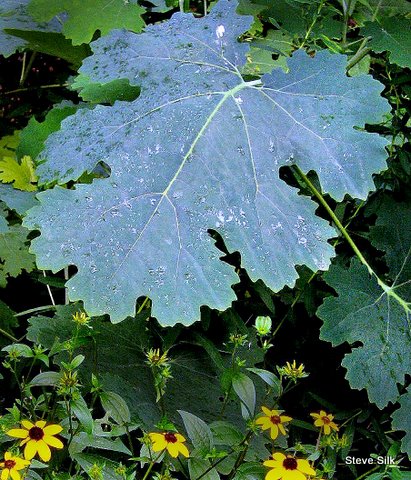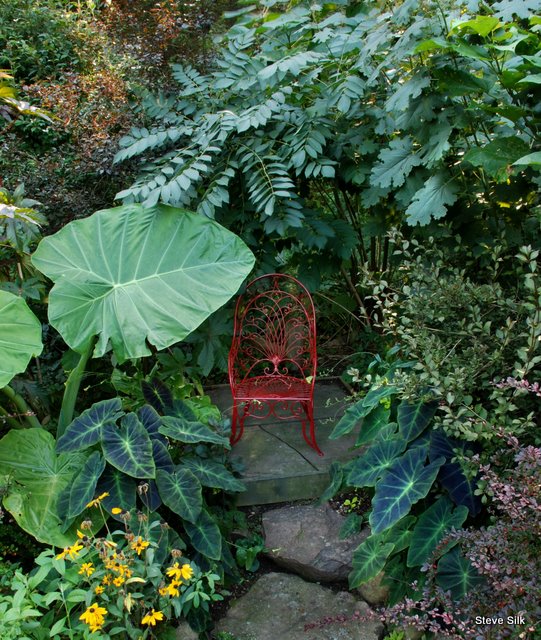I’m not making any apologies for the, uh, shall we say the more “robust” nature of several plants in my garden. Plume poppy (Macleaya cordata) is certainly one of them. The exuberance of its architectural pizzazz is matched, or nearly so, by the plant’s tendency to travel. I’m not saying it’s invasive-I try to stay away from anything that spreads rampantly by seed–but friends make fun of my predilection for the plumed wonder and similarly vagabond-prone garden thugs (which spread by running roots rather than seed). They say I make too much work for myself. And a Gardenweb post rails about the curse of the plume poppy. Gimme a break! This is one gorgeous plant. You just have to put it in the right place.

In the right place, plume poppy is a plant of stellar attributes. Let’s count the reasons:
1) Big dinner-plate sized leaves–and I like my leaves big, since working with oversized leaves really opens up your options for making dramatic shape- and size-based combinations that confound a traditional sense of scale in the garden.
2) An intriguing leaf edge–each richly scalloped and lobed leaf is equal parts curiousity and beauty.
3) That alluring silvery blue hue–plume poppy’s foliage is one of those goes-well-with-everything colors that make it a welcome companion in almost any color scheme. And let’s not forget the ghostly, whitish underside of the leaves, which is sometimes revealed by a stray gust of wind.
4) The plumes–oh yeah, those tall, finely textured, creamy white spires that make up the plume poppy’s flower are, again, a shape, texture and color that looks good with everything.
5) Stature–these plants are among the taller perennials and can top off at eight feet, so they are well suited to creating dramatic backdrops or cool-looking specimen plantings.
6) A sturdy constitution–plume poppies are not going to get whiny about a lack of drinking water, or whimper about less than ideal soil. They take everything from full sun to part shade. They’re tough.
7) They’re versatile–plume poppies fit right in with perennial and mixed borders, and they’re at home in more eclectic plantings like this tropicalesque corner of my garden.

On the downside, yes, they can be vigorously rhizomatous spreaders. But their imperialistic, empire-building tendencies are so easily thwarted! Each spring, when emerging plants are just a few inches tall, I stage a pre-emptive strike. I patrol the edges of my plume poppy clusters, and yank any outlying clumps may be forming a breakaway republic. They come out of the ground very easily, and one inspection a season usually suffices. I only worry about this in one spot, where I’ve used plume poppy to accent a small rise. By planting lower growing shrubs and perennials at the bottom of the small slope and tall things like trees and plume poppy up top (that ‘s it at the upper right of the photo topping this post, happily waving its plumes), I’ve made the change in height appear more dramatic. I’m fortunate to have a large garden and since I usually plant this lovable hulk only in problem areas where it can run to its heart’s content, I rarely do anything at all to tend plume poppy (see reason #6, above), other than appreciate it.
Our archive of articles is so deep at GGW that I have begun to go back into reading and posting them from time to time. Although Steve Silk no longer writes for GGW, he is an avid plants man whose love for gardening is evident in his writing. Would love to hear your comments – ideas, successes, problems, siting suggestion- and anything else you want to share about this delicate looking, yet very assertive perennial. Fran

